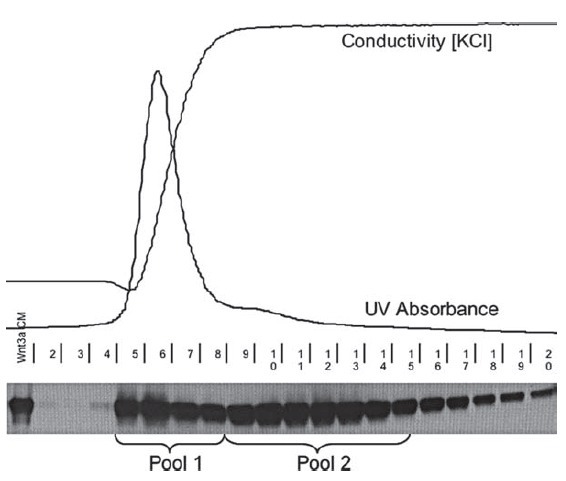v468 Chapter 7 通过免疫组化来测定β-连环蛋白核定位
丁香园
3944
Detection of b-Catenin Localization by Immunohistochemistry
Methods in Molecular Biology v468. chapter 7
Abstract
β-catenin is a widely expressed 90-kDa protein with dual functions in cell adhesion and Wnt signalling. At the membrane, β-catenin forms complexes with E-cadherin to generate cell adhesion complexesresponsible for maintaining the structural integrity of many epithelial tissues. On the other hand, accumulationof β-catenin in the nucleus in response to Wnt signalling facilitates complex formation with Tcftranscription factors, leading to activation of a genetic program influencing a range of cellular processesincluding cell growth, cell movement, and cell fate. Chronic activation of the Wnt signalling pathway as aresult of mutations in key pathway components, including β-catenin itself, is a major cause of cancer. Theassociated increase in nuclear β-catenin protein is therefore considered to be a hallmark of Wnt-drivencancers and an invaluable tool to detect active Wnt signalling.
Key words: Immunohistochemistry : Antibody : Wnt signalling : β-catenin : Nuclear localization .
1. Introduction
β-catenin has long been known to have a crucial role in cell adhesionas a component of the E-cadherin complex at the cell membrane. Just over a decade ago, we discovered that β-catenin is notfaithful to E-cadherin—it also forms specific complexes with Tcftranscription factors in the nucleus in response to activation ofthe canonical Wnt signalling cascade (1 – 3) . In the absence of a Wnt signal, β-catenin is serially phosphorylatedat a set of conserved serine/threonine residues at its Nterminusby the actions of the kinases, casein kinase (CK)-1 andglycogen synthase kinase (GSK)-3 (see Chapter 1 for an overview).This marks β-catenin for recognition by the β-transducin repeat-containing protein (β-TRCP) ubiquitin ligase and targetsit for degradation by the proteasome. Activation of the canonicalWnt signalling cascade triggers the accumulation of non-phosphorylatedβ-catenin in the cytoplasm. β-Catenin subsequentlyenters the nucleus where it binds Tcf proteins to generate activetranscription factor complexes capable of activating a set of Wnttarget genes and eliciting a physiological response from the cell.This response is usually transient, with β-catenin being rapidlycleared from the nucleus following dissipation of the Wnt signalat the membrane. However, chronic accumulation of β-cateninin the nucleus sometimes occurs following mutation of key Wntpathway components that prevent effective regulation of β-cateninlevels in the cell. The resulting constitutive activation of theWnt target gene program is considered to be a major contributingfactor in many human disorders including cancers and oligodontia(tooth loss) (4) .
In simple terms, the presence of β-catenin in the nucleuscan be viewed as evidence of Wnt signalling activity in a tissue. Intissue sections, this is most commonly visualized by immunohistochemistryusing commercially available antibodies recognizingβ-catenin.
2. Materials
2.1. Tissue Block Preparation
1. Formalin: 4% (w/v) formaldehyde in phosphate-bufferedsaline (PBS).
2. Tissue-dehydration solutions series: 70%, 96%, and 100%(v/v) ethanol.
3. Xylene.
4. Liquid paraffin (60°C).
2.2. Tissue Section Preparation
1. De-wax solvent: Xylene.
2. Tissue-rehydration solutions series: 100%, 96%, 80%, 70%,60%, and 25% (v/v) ethanol.
3. Tissue cassettes (Klinipath , Duiven, The Netherlands).
4. Slide racks (Klinipath).
5. Cold plate (approximately –12°C).
6. Microtome.
7. Starfrost microscope slides.
8. Coverslips (Menzel-Gl?ser, Braunschweig, Germany).
2.3. Immunohistochemical Staining
1. Peroxidase (PO) blocking buffer: 0.040 M citric acid, 0.121M disodium hydrogen phosphate, and 0.030 M sodium azide.
Add 1 mL of H 2 O 2 solution (30% [v/v] stock solution) per 10mL PO blocking buffer before use (see Note 1 ).
2. Antigen retrieval solution: 10 mM Tris and 1 mM EDTA, pH 9.0.
To prepare, dissolve 1.2 g Tris and 0.37 g EDTA in 1 L distilledwater and dissolve by stirring. The resulting solution shouldalready be at the required pH 9.0.
3. Steel pan for boiling slides (we use a high-sided asparagus pan).
4. Hot plate.
5. PBS.
6. Pre-blocking buffer: 0.05% (w/v) bovine serum albumin(BSA) in PBS.
7. 30% (w/v) Hydrogen peroxide (H 2 O 2 ) stock solution.
8. Anti-β-catenin antibody diluted 1:100 (BD Transduction Laboratories,Franklin Lakes, NJ; #610154) in pre-blocking buffer.
9. Polymer horseradish peroxidase (HRP)-labelled anti-mouseEnvision (Dako, Glostrup, Denmark) (see Note 2 ).
10. Diaminobenzidine (DAB) peroxidase substrate. To makeup 10× DAB, dissolve 600 mg DAB (Sigma, St. Louis,MO) in 100 mL distilled water. Make aliquots of 1 mLand store at –20°C. Dilute the 10× DAB before use with9 mL of phosphate–citrate buffer and then add 10 μL of30% H 2 O 2 stock. Protect from light. Diluted DAB/H 2 O 2solution is stable at room temperature for up to 6 h. Discardunused solution.
11. Mayer’s haematoxylin. To prepare, dissolve 1 g haematoxylin-monohydrate (Merck), 0.2 g sodium iodate, 50 g aluminumpotassium sulphate dodecahydrate (Alum), 50 g chloralhydrate, and 1 g citric acid in 1 L of distilled water by stirringwell for at least 1 h.
12. Slide-mounting solutions series: 50%, 60%, 70%, 96%, and100% (v/v) ethanol, and xylene.
13. Pertex mounting medium (Histolab, Gothenburg, Sweden).
3. Methods
Levels of β-catenin present in the adhesion complexes at themembrane are generally not influenced by Wnt signalling. Thisis in stark contrast to β-catenin levels in the cytoplasm and nucleus, which vary dramatically according to the status of theWnt signalling pathway. If we take the intestine as an example,immunohistochemical staining using β-catenin antibodies readilydetects β-catenin at the membrane, cytoplasm, and nucleusof cells located towards the base of the crypts of Lieberkuhn(see Fig. 7.1a and b ). This reflects the presence of an activeWnt signalling pathway in this region of the tissue. In contrast,β-catenin is only visible at the membrane of epithelial cells onthe villi, reflecting the absence of Wnt signalling in this tissue(see Fig. 7.1a ). As we already discussed, several different humancancers are thought to be driven by inappropriate activation ofthe Wnt pathway, which leads to the uncontrolled accumulationof β-catenin in the cytoplasm and nucleus. This is particularlyevident in intestinal polyps, which are the earliest stagesof colon cancer (see Fig. 7.1c ). Immunohistochemical stainingusing specific β-catenin antibodies is therefore a powerful toolfor determining not only where active Wnt signalling is presentwithin a tissue, but can also be used to detect early Wnt-drivencancers.
Fig. 7.1. Detection of β-catenin in tissue sections. Immunohistochemical staining of β-catenin in mouse small intestineusing the BD Transduction Laboratories monoclonal antibody #610154. A β-Catenin is visible only at the membrane onthe villus epithelium (black arrow). A, B β-Catenin accumulates in the nucleus of Paneth cells at the base of the intestinalcrypts (white arrows), reflecting the presence of an activated Wnt signalling pathway in this region. C Massive accumulationof β-catenin in the cytoplasm and nucleus of an early intestinal adenoma as a result of constitutive activation of theWnt signalling pathway (circled).
3.1. Preparation of Paraffin-Embedded Tissue Sections
1. Place the freshly isolated tissues immediately into a 50-mLFalcon tube containing at least a 10-fold volume of formalin(4% formaldehyde). Fix the tissues by constant mixing on arolling platform overnight at room temperature.
2. Remove the formalin and wash the tissues twice for 20 mineach in PBS at room temperature on a rolling platform.
3. Transfer the tissues into a Klinipath tissue cassette and labelthe front panel clearly using a pencil to record the tissuetype, origin, and date.
4. Dehydrate the tissues by immersing the cassette in a 20-foldvolume of 70% ethanol for 2 h at 4°C (see Note 3 ). The 70%ethanol is refreshed after 1 h. This procedure is repeatedusing 96% ethanol and then 100% ethanol.
5. Transfer the tissue cassettes to a 20-fold volume of xyleneand incubate for 2 h at room temperature.
6. Remove the tissue cassettes from the xylene and dab ontotissues to remove any excess solvent. Then immerse the cassettesin liquid paraffin (60°C) overnight.
7. Remove the tissue cassettes from the liquid paraffin andtransfer them to an embedding station, where they areembedded in paraffin using metal moulds. Carefully orientthe tissues within the paraffin using heated forceps. Transferthe paraffin blocks to a cold-plate for 30 min to allow themto solidify.
8. Prepare 4-μm-thick sections using a microtome and transferthem to a clean water bath (at 40°C). The sections areallowed to spread out on the water and then floated onto theupper surface of coated microscope slides.
9. Transfer the slides into a slide rack and de-wax the slides byimmersing in xylene (2× 5 min).
10. Hydrate the tissue sections by serial immersion in 100% ethanol(2× 1 min), 96% ethanol (2× 1 min), 70% ethanol (2× 1min), and then distilled water (2× 1 min).
3.2. Immunohistochemical Staining Using Anti-b-catenin Antibodies
1. Rinse the slides three times for 15 sec each in distilled water.
2. Block endogenous peroxidase activity by immersing the sliderack containing the slides in a Klinipath container filled withPO-peroxidase blocking buffer for 15 min at room temperature(see Note 4 ).
3. Rinse the slide rack containing the slides three times for 15sec each in distilled water.
4. Antigen retrieval is achieved by immersing the slides in a panof boiling Tris-EDTA, pH 9.0, for 20 min (see Note 5 ).
5. Wash the slides three times for 2 min each by immersion in PBS.
6. Transfer the slides onto a staining platform of choice withthe tissue surface facing upwards.
7. Add pre-blocking buffer drop-wise from a height of ~10cm using a disposable Pasteur pipette (Sarstedt) so that theentire slide surface is covered. Then incubate the slides atroom temperature for 30 min to facilitate blocking of nonspecificbinding of the antibody.
8. Drain the pre-blocking buffer off the slide onto tissue paperand dab the edges of the slides onto the tissues to ensureexcess fluid is removed from the surface of the slide.
9. Add 125 μL of the primary β-catenin antibody (diluted1:100 in pre-blocking buffer—see Note 6 ) drop-wise froma height of ?10 cm to cover the entire slide surface (see Note 7 ).
Then incubate the slides in a humid atmosphere at roomtemperature for 2 h.
10. Transfer the slides to a slide rack and rinse them three timesfor 2 min each in PBS.
11. Return the slides to the staining platform and add 125 μLof anti-mouse Envision (polymer HRP-labelled) to the surfaceof the slide as described above. Incubate the slides in ahumid atmosphere at room temperature for 1 h.
12. Transfer the slides to a slide rack and rinse them three timesfor 2 min each in PBS.
13. Return the slides to the staining platform and detect boundperoxidase activity by adding the DAB substrate to the slidesurface as described above. Incubate the slides at room temperaturefor 10 min.
14. Transfer the slides to a slide rack and rinse them three timesfor 2 min each in PBS.
15. Counterstain the nuclei by immersing the slides in Mayer’s haematoxylinfor 2 min. Remove excess counterstain by rinsing theslides under running tap water for 5 min (see Note 8 ).
16. The samples are then ready to be mounted. Dehydrate theslides by serial immersion for 1 min each in 50% and 60%ethanol, followed by 2 min each in 70% and 96% ethanol,and finally three times 1 min each in fresh volumes of 100%ethanol. The slides are then immersed twice for 1 min eachin xylene.
17. Add mounting medium (Pertex) and gently place a coverslipover the tissue sample. Remove air bubbles from under the coverslipby gently applying pressure from above using forceps.
18. The slides are then viewed under a phase-contrast microscopefor evidence of β-catenin staining. Nuclei will be stainedblue, whilst β-catenin will be readily visible as a brown stain. Examples of β-catenin staining at the membrane and in thenucleus are shown in Fig. 7.1 (note that the tissue in Fig. 7.1has only been lightly counterstained to allow grey-tone printing).
4. Notes
1. Unless otherwise stated, all solutions are prepared using distilledwater.
2. In our experience, when detecting binding of mouse primaryantibodies such as the BD Transduction Laboratoriesanti-β-catenin, the anti-mouse Envision secondary antibodieslabelled with HRP consistently give the best signal-tobackgroundratio.
3. All dehydration steps using ethanol are performed at 4°C toensure a gradual reduction in hydroxyl (water) bonds withinthe tissue, thereby reducing tissue damage and minimizing thepossibility of disrupting antibody binding sites.
4. The PO-peroxidase blocking buffer should always be freshlyprepared.
5. It is important to start timing 20 min only after the pan hasagain reached the boiling point following immersion of theslides. Formalin fixation generates protein cross-links that maskthe antigenic sites in tissue specimens, thereby producing weakor false negative staining for immunohistochemical detectionof some proteins. The Tris-EDTA-based antigen retrieval procedureis designed to break these protein cross-links, therebyunmasking the antigens and epitopes in formalin-fixed andparaffin-embedded tissue sections and enhancing the stainingintensity of the β-catenin antibodies.
6. We have found the BD Transduction Laboratories monoclonalantibody to be the most consistent in detectingnuclear β-catenin on paraffin tissue sections. However, thisprocedure can, in principle, be adapted for other commerciallyavailable antibodies.
7. Great care should always be taken to ensure sufficient blocking.
Also, the antibody solutions should be added to theslides in sufficient volumes to achieve complete submersionof the tissue section. The tissue sections should never beallowed to dry out during the staining procedure to avoidthe appearance of non-specific background staining.
8. Mayer’s haematoxylin is a commonly used counterstain thatcolors the nuclei blue.
References
1. Behrens, J., von Kries, J. P., Kuhl, M.,
Bruhn, L., Wedlich, D., Grosschedl, R.,
et al. (1996) Functional interaction of betacateninwith the transcription factor LEF-1.
Nature 382 , 638–642.
2. Molenaar, M., van de Wetering, M.,
Oosterwegel, M., Peterson-Maduro, J.,
Godsave, S., Korinek, V., et al. (1996) XTcf-3 transcription factor mediates beta-catenininducedaxis formation in Xenopus embryos.
Cell 86 , 391–399.
3. van de Wetering, M., Cavallo, R., Dooijes,D., van Beest, M., van Es, J., Loureiro, J.,
et al. (1997) Armadillo coactivates transcriptiondriven by the product of the Drosophila
segment polarity gene dTCF. Cell
88 , 789–799.
4. Barker, N. and Clevers, H. (2006) Mining the Wnt pathway for cancer therapeutics. Nat. Rev. Drug. Discov. 5 , 997–1014.











